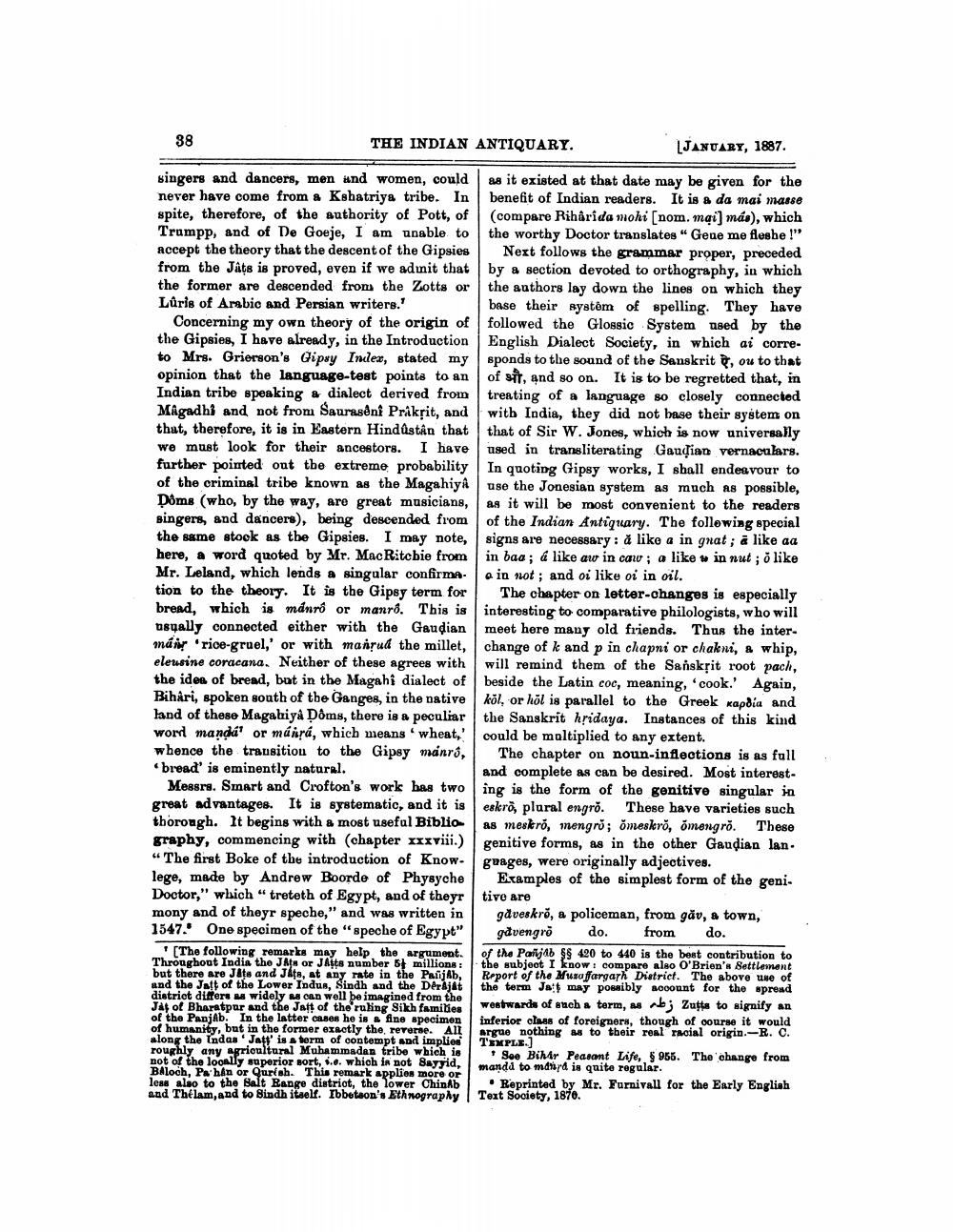________________
38
singers and dancers, men and women, could never have come from a Kshatriya tribe. In spite, therefore, of the authority of Pott, of Trumpp, and of De Goeje, I am unable to accept the theory that the descent of the Gipsies from the Jâts is proved, even if we admit that the former are descended from the Zotts or Lûris of Arabic and Persian writers."
THE INDIAN ANTIQUARY.
Concerning my own theory of the origin of the Gipsies, I have already, in the Introduction to Mrs. Grierson's Gipsy Index, stated my opinion that the language-test points to an Indian tribe speaking a dialect derived from Magadhi and not from Saurasênî Prakrit, and that, therefore, it is in Eastern Hindustan that we must look for their ancestors. I have further pointed out the extreme probability of the criminal tribe known as the Magahiyâ Dôms (who, by the way, are great musicians, singers, and dancers), being descended from the same stock as the Gipsies. I may note, here, a word quoted by Mr. MacRitchie from Mr. Leland, which lends a singular confirma tion to the theory. It is the Gipsy term for bread, which is mánró or manro. This is usually connected either with the Gaudian már rice-gruel,' or with manṛud the millet, eleusine coracana. Neither of these agrees with the idea of bread, but in the Magahi dialect of Bihari, spoken south of the Ganges, in the native land of these Magahiya Dôms, there is a peculiar word manda or mánrá, which means wheat,' whence the transition to the Gipsy mánró, bread' is eminently natural.
Messrs. Smart and Crofton's work has two great advantages. It is systematic, and it is thorough. It begins with a most useful Biblio graphy, commencing with (chapter xxxviii.) "The first Boke of the introduction of Knowlege, made by Andrew Boorde of Physyche Doctor," which "treteth of Egypt, and of theyr mony and of theyr speche," and was written in 1547. One specimen of the "speche of Egypt"
[The following remarks may help the argument. Throughout India the JAts or JAtts number 5 millions: but there are Jats and Játs, at any rate in the Panjab, and the Jatt of the Lower Indus, Sindh and the Derajat district differs as widely as can well be imagined from the Jat of Bharatpur and the Jaft of the ruling Sikh families of the Panjab. In the latter cases he is a fine specimen of humanity, but in the former exactly the, reverse. All along the Indas Jatt' is a term of contempt and implies roughly any agricultural Muhammadan tribe which is not of the locally superior sort, s.e. which is not Sayyid, Baloch, Pa han or Qurish. This remark applies more or less also to the Salt Range district, the lower Chinab and Thelam, and to Sindh itself. Ibbetson's Ethnography
JANUARY, 1887.
as it existed at that date may be given for the benefit of Indian readers. It is a da mai masse (compare Rihârida mohi [nom. mai] más), which the worthy Doctor translates "Gene me fleshe!" Next follows the grammar proper, preceded by a section devoted to orthography, in which the authors lay down the lines on which they base their system of spelling. They have followed the Glossic System used by the English Dialect Society, in which ai corresponds to the sound of the Sanskrit, ou to that of sit, and so on. It is to be regretted that, in treating of a language so closely connected with India, they did not base their system on that of Sir W. Jones, which is now universally used in transliterating Gaudian vernaculars. In quoting Gipsy works, I shall endeavour to use the Jonesian system as much as possible, as it will be most convenient to the readers of the Indian Antiquary. The following special signs are necessary: à like a in gnat; a like aa in baa; & like aw in caw; a like in nut; o like a in not; and oi like oi in oil.
The chapter on letter-changes is especially interesting to comparative philologists, who will meet here many old friends. Thus the interchange of k and p in chapni or chakni, a whip, will remind them of the Sanskrit root pach, beside the Latin coc, meaning, 'cook.' Again, kol, or hol is parallel to the Greek kapdía and the Sanskrit hridaya. Instances of this kind could be multiplied to any extent.
The chapter on noun-inflections is as full and complete as can be desired. Most interesting is the form of the genitive singular in eskro, plural engro. These have varieties such as meskro, mengro; omeskro, omengro. These genitive forms, as in the other Gaudian lan. guages, were originally adjectives.
Examples of the simplest form of the genitive are
gåveskro, a policeman, from gäv, a town, gavengro do. from do.
of the Panjab §§ 420 to 440 is the best contribution to the subject I know: compare also O'Brien's Settlement Report of the Musaffargarh District. The above use of the term Jat may possibly account for the spread westwards of such a term, as bj Zutts to signify an inferior class of foreigners, though of course it would argue nothing as to their real racial origin.-R. C. TEMPLE.]
See Bihar Peasant Life, § 955. The change from manda to manyd is quite regular.
Reprinted by Mr. Furnivall for the Early English Text Society, 1870.




